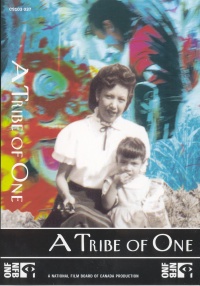| ________________
CM . . .
. Volume XI Number 6 . . . .November 12, 2004
A Tribe of One would be compelling viewing for Grade 11 and 12 students and for adults. The "tribe of one" is Rhonda Larrabee, the focus of the film, who discovered that she was the last of the New Westminster Indians. Mrs. Larrabee, nee "Lee," grew up in Vancouver near her father's Chinese-Canadian relatives, believing that she was Chinese and French on her mother's side. In her early twenties, married and a mother herself, Rhonda completed her paternal family tree, then asked her mother about her ancestry. Her mother agreed to talk about it once, and no more, because it was too painful. To Rhonda's surprise, she learned that her mother was First Nations, a member of the last family to live on the New Westminster Reserve. Orphaned at an early age, Marie Joseph went to the Kamloops Indian Residential School where she was overworked and punished for speaking her native language. On leaving school, Marie lived with her sister Doe in Vancouver and worked as a waitress. Doe, a tailor, created smart outfits for herself and her sister. Everybody believed that these pretty, popular sisters were of Asian descent, perhaps Chinese or Hawaiian, and the young women, who had suffered prejudice as native people, let people think what they wanted. Marie eventually married Art Lee, but the marriage ended when Marie was hospitalized with tuberculosis. On recovering, Marie married a friend of the family who became Rhonda's father-figure. After Marie's death in 1985, he encouraged Rhonda to delve into her maternal background. "It's time somebody made her proud," he said, "so go ahead and do it." Regarding her mother's First Nations heritage, Rhonda says, "It was nothing for her to be ashamed of, but she was, and I want to make it right." Rhonda and her husband, Bryan Larrabee, working as a research team, discovered the grave of her grandfather, George Joseph, in a New Westminster Anglican cemetery. They learned that the New Westminster Band had existed from the 1870s until 1913 when the federal government decided that the number and size of British Columbia reservations should be reduced. Bands were merged. The New Westminster reserve was closed. The land is now privately owned and urbanized. To feel more connected to her mother, Rhonda applied for a status card and was registered as an Indian of the New Westminster Indian Band of British Columbia. Having established that this band existed, her brothers, Rod Bandura and Ron Lee, also got their cards. Strangers contacted her, saying, "I knew your grandfather and grandmother." She and her brothers form the nucleus of a growing extended family. Rhonda would like some sort of land base for the New Westminster Indians so that young people from the north could come there and make friends. The most important result of her efforts, however, is shown when her granddaughter Jade says that she feels good about being native. The articulate family members, interesting old photographs and musical finale, all contribute to the appeal of this highly recommended film. Highly Recommended. Ruth Latta is a writer in Ottawa, ON.
To comment
on this title or this review, send mail to cm@umanitoba.ca.
Copyright © the Manitoba Library Association. Reproduction for personal
use is permitted only if this copyright notice is maintained. Any
other reproduction is prohibited without permission.
NEXT REVIEW |
TABLE OF CONTENTS FOR THIS ISSUE
- November 12, 2004.
AUTHORS |
TITLES |
MEDIA REVIEWS |
PROFILES |
BACK ISSUES |
SEARCH |
CMARCHIVE |
HOME |
